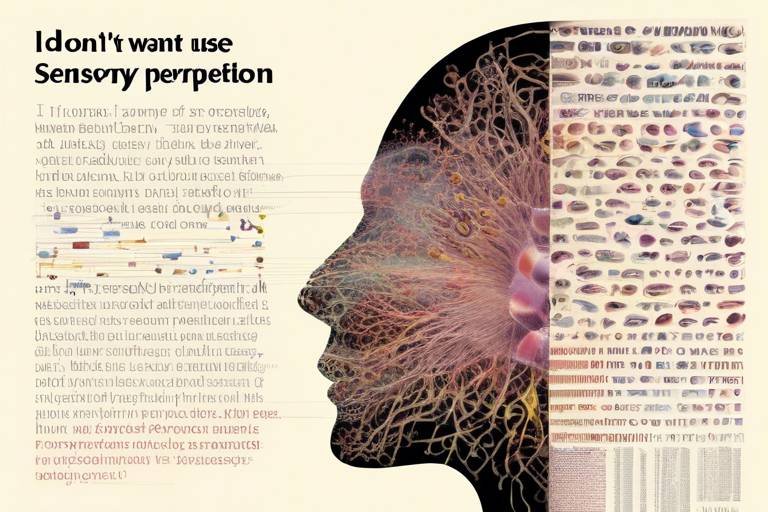How Environmental Factors Influence Health - The Science
Have you ever wondered how the world around you affects your health? It's not just about what you eat or how much you exercise; the environment plays a crucial role in shaping our well-being. From the air we breathe to the neighborhoods we live in, various environmental factors can significantly influence our health outcomes. In this article, we will explore the intricate web of connections between environmental elements and our health, revealing how they can either enhance our quality of life or contribute to disease prevalence.
For instance, consider the air quality in your city. Poor air quality is not just an inconvenience; it's a silent killer. Pollutants and particulate matter can lead to respiratory diseases, impacting your lung health and overall quality of life. Similarly, access to clean drinking water is essential. Contaminated water sources can lead to a host of health issues, from gastrointestinal diseases to long-term chronic conditions. It's a stark reminder that our environment is not just a backdrop to our lives but a vital component of our health.
Moreover, the design of our urban spaces has profound implications for our mental well-being. Imagine living in a city with ample green spaces and walkable neighborhoods. Such environments foster social interaction and promote psychological well-being. In contrast, urban areas lacking these features can lead to feelings of isolation and stress. This connection between urban design and mental health is a critical area of study that highlights the importance of creating spaces that nurture rather than hinder our health.
As we delve deeper, we must also consider the impact of climate change on health. Rising temperatures and shifting ecosystems are not just environmental concerns; they are public health issues. Changes in climate can influence the spread of infectious diseases, creating potential health crises that can affect entire communities. The interconnectedness of these factors illustrates that our health is intricately linked to the health of our planet.
In addition to these factors, we cannot overlook the role of noise pollution. Chronic exposure to high noise levels can lead to serious cardiovascular issues, including hypertension and heart disease. Often dismissed as a mere nuisance, noise pollution deserves our attention as a significant contributor to health problems, reminding us that a peaceful environment is essential for maintaining good health.
Furthermore, the availability of healthy food options is heavily influenced by environmental factors. Food deserts—areas with limited access to nutritious food—can have dire consequences for public health. Poor agricultural practices can exacerbate these issues, leading to malnutrition and related health problems. Understanding the food environment is crucial for addressing these disparities and promoting better nutrition for all.
Housing conditions also play a pivotal role in our health. Substandard housing can lead to numerous health problems, from respiratory issues due to mold and poor air quality to mental health challenges stemming from unsafe living conditions. The relationship between housing quality and health outcomes highlights the need for policies that ensure safe and healthy living environments for everyone.
Lastly, socioeconomic factors are intertwined with environmental influences, creating disparities in health outcomes. Individuals from lower socioeconomic backgrounds often face greater environmental challenges, leading to increased health risks. Addressing these disparities requires a comprehensive understanding of how environmental factors intersect with socioeconomic conditions.
In conclusion, the relationship between environmental factors and health is complex and multifaceted. As we continue to unravel this intricate connection, it becomes clear that improving our environmental conditions is not just an ecological concern; it's a public health imperative. By understanding and addressing these factors, we can enhance our quality of life and promote better health outcomes for all.
- What are environmental factors? Environmental factors include elements like air quality, water supply, urban design, climate, and socioeconomic conditions that can impact health.
- How does air quality affect health? Poor air quality can lead to respiratory diseases, cardiovascular issues, and can significantly decrease overall quality of life.
- Why is access to clean water important? Clean water is essential for preventing gastrointestinal diseases and other health issues that arise from contaminated sources.
- Can urban design influence mental health? Yes, urban design that includes green spaces and walkability can enhance mental well-being and encourage social interaction.
- How does climate change impact health? Climate change can alter the spread of infectious diseases and create health crises due to changing ecosystems.

Air Quality and Respiratory Health
When we think about our health, many of us focus on diet and exercise, but have you ever considered the air you breathe? Air quality is a silent yet potent player in our overall health, particularly when it comes to our respiratory system. Poor air quality is a significant contributor to respiratory diseases, and its effects can be both immediate and long-lasting. Imagine walking through a bustling city, surrounded by cars, factories, and construction sites—each of these contributes to a cocktail of pollutants that can wreak havoc on your lungs.
Pollutants such as particulate matter (PM), nitrogen dioxide (NO2), and sulfur dioxide (SO2) are common culprits that can impair lung function and lead to chronic conditions like asthma and chronic obstructive pulmonary disease (COPD). Research has shown that exposure to these pollutants can trigger inflammation in the airways, making it harder to breathe and increasing the risk of respiratory infections. In fact, a study published in the American Journal of Respiratory and Critical Care Medicine found that individuals living in areas with high levels of air pollution are significantly more likely to develop respiratory diseases compared to those in cleaner environments.
But what exactly are these pollutants, and how do they affect us? Here’s a quick breakdown:
- Particulate Matter (PM): Tiny particles that can penetrate deep into the lungs and even enter the bloodstream.
- Nitrogen Dioxide (NO2): A gas produced from burning fossil fuels that can irritate airways and reduce lung function.
- Sulfur Dioxide (SO2): A gas that can contribute to the formation of acid rain and respiratory problems when inhaled.
It's not just the pollutants themselves that are concerning; the duration and intensity of exposure play critical roles as well. For instance, living in a city with heavy traffic can lead to chronic exposure, which accumulates over time. This is where the concept of cumulative risk comes into play. The longer you breathe in polluted air, the higher your chances of experiencing serious health issues. Children, the elderly, and those with pre-existing health conditions are particularly vulnerable, making it essential to address air quality as a public health priority.
Moreover, the impact of air quality extends beyond just respiratory health. Emerging studies suggest links between air pollution and mental health issues, cardiovascular diseases, and even premature death. For example, a systematic review in the Journal of the American College of Cardiology highlighted a strong correlation between long-term exposure to fine particulate matter and increased rates of heart disease.
As we navigate our daily lives, it's crucial to stay informed about air quality in our surroundings. Many cities now provide real-time air quality indices (AQI) that can help us make informed decisions about outdoor activities. On days when pollution levels are high, consider staying indoors, using air purifiers, and wearing masks if necessary. Remember, protecting your lungs is just as important as any workout or healthy meal!
In conclusion, the relationship between air quality and respiratory health is complex but undeniably significant. By understanding the pollutants that affect us and taking proactive measures to minimize exposure, we can breathe easier and live healthier lives.
- What are the main sources of air pollution? Major sources include vehicle emissions, industrial discharges, and household products.
- How can I check the air quality in my area? You can check your local air quality index (AQI) through government websites or various mobile apps.
- What are some ways to improve indoor air quality? Use air purifiers, ventilate your home regularly, and avoid smoking indoors.

Water Quality and Health Outcomes
Access to clean water is not just a luxury; it is a fundamental human right that underpins our very existence. Imagine turning on your tap and not being able to trust that the water flowing out is safe to drink. Unfortunately, this is a reality for millions around the globe. Contaminated water sources can lead to a myriad of health issues, ranging from mild gastrointestinal disturbances to severe chronic conditions. The implications of poor water quality are profound and far-reaching, affecting not only individual health but also community well-being.
One of the most alarming consequences of contaminated water is the prevalence of gastrointestinal diseases. Waterborne pathogens, such as bacteria and viruses, can wreak havoc on our digestive systems. According to the World Health Organization, unsafe drinking water is responsible for over 500,000 deaths each year from diarrheal diseases alone. This is a staggering statistic that highlights the urgent need for clean water access. Furthermore, long-term exposure to contaminated water can lead to chronic conditions, such as kidney disease and liver damage, which can significantly diminish quality of life.
In addition to gastrointestinal issues, water quality can also influence other health outcomes. For instance, the presence of heavy metals like lead and arsenic in drinking water has been linked to neurological disorders, particularly in children. These toxins can impair cognitive development and lead to lifelong health challenges. It's like trying to build a house on a shaky foundation; without a solid base, everything that follows is at risk of collapsing. The importance of maintaining clean water sources cannot be overstated.
Moreover, the environmental factors contributing to water quality are often interconnected. For example, agricultural runoff can introduce harmful pesticides and fertilizers into water supplies, exacerbating the problem. Urbanization and industrial activities can also lead to increased pollution, further compromising water safety. It’s a vicious cycle that demands immediate attention. To illustrate this, consider the following table that outlines common contaminants found in water sources and their associated health risks:
| Contaminant | Source | Health Risks |
|---|---|---|
| Lead | Old pipes, industrial waste | Neurological damage, developmental issues in children |
| Arsenic | Natural deposits, agricultural runoff | Cancer, skin lesions, developmental effects |
| Nitrates | Fertilizer runoff | Methemoglobinemia (blue baby syndrome), thyroid issues |
| Bacteria (E. coli) | Animal waste, sewage | Diarrhea, urinary tract infections |
Addressing water quality is not merely a matter of public health; it is also an issue of social justice. Communities in low-income areas often bear the brunt of contaminated water sources, leading to significant health disparities. It's crucial to recognize that health outcomes are not just a product of individual choices but are heavily influenced by the environments in which people live. Therefore, improving water quality must be a collective effort, involving policymakers, community leaders, and individuals alike.
In conclusion, the relationship between water quality and health outcomes is complex and multifaceted. Clean water is essential for maintaining health and preventing disease. As we strive to improve public health, we must prioritize access to safe drinking water for all. After all, when it comes to health, we cannot afford to take a backseat. It’s time to take action and ensure that everyone has access to the clean water they deserve.
- What are the main sources of water contamination? Common sources include industrial waste, agricultural runoff, and sewage discharge.
- How can I ensure my drinking water is safe? Consider using water filters, regularly testing your water, and staying informed about local water quality reports.
- What health issues are most commonly associated with contaminated water? Gastrointestinal diseases, neurological disorders, and various chronic conditions can arise from unsafe drinking water.

Urban Design and Mental Well-being
Urban design plays a crucial role in shaping not just our cities but also our minds. Imagine stepping out of your home into a bustling metropolis filled with concrete and noise—how does that make you feel? Now picture a vibrant park with trees swaying in the breeze, children laughing, and people engaging in leisurely walks. The difference is palpable, isn’t it? Good urban design can create environments that foster mental well-being, while poor design can lead to increased stress and anxiety.
Research has shown that urban environments significantly affect our mental health. For instance, cities that prioritize green spaces allow residents to connect with nature, which has been linked to reduced levels of stress and improved mood. A study conducted in various urban areas found that individuals living near parks reported feeling happier and less anxious compared to those in densely built environments. This phenomenon can be attributed to the calming effects of nature, which acts as a buffer against the chaos of urban life.
Moreover, walkable neighborhoods promote social interaction, which is vital for mental health. When people can easily walk to shops, cafes, or community centers, they are more likely to engage with others, fostering a sense of belonging and community. Conversely, poorly designed urban areas that prioritize cars over pedestrians can lead to isolation and loneliness. Think about it: when was the last time you struck up a conversation with a stranger while stuck in traffic?
Additionally, the layout of urban spaces can impact how we perceive safety. Well-lit streets, open spaces, and clear sightlines can enhance feelings of security, while dark alleys and hidden corners can create anxiety. A sense of safety encourages people to explore their neighborhoods, participate in outdoor activities, and engage with their community, all of which contribute positively to mental well-being.
To illustrate the impact of urban design on mental health, consider the following table that highlights key elements of urban environments and their psychological effects:
| Urban Design Element | Positive Psychological Impact | Negative Psychological Impact |
|---|---|---|
| Green Spaces | Reduces stress, promotes relaxation | Lack of access can lead to anxiety and depression |
| Walkability | Encourages social interaction, boosts mood | Isolation in car-centric designs |
| Safety Features | Enhances feelings of security | Increased anxiety in unsafe areas |
Moreover, the concept of community design cannot be overlooked. Urban areas that incorporate mixed-use developments—where residential, commercial, and recreational spaces coexist—tend to foster a stronger sense of community. This integration not only makes life more convenient but also encourages social cohesion, which is essential for mental health. When people feel connected to their community, they are more likely to support one another, leading to improved overall well-being.
In conclusion, the design of our urban landscapes significantly influences our mental well-being. By prioritizing green spaces, walkability, safety, and community integration, we can create environments that nurture our minds and foster healthier, happier lives. As we continue to develop and expand our cities, it is essential to keep mental health at the forefront of urban planning discussions. After all, a well-designed city is not just about aesthetics; it’s about creating a space where people can thrive.
- How does urban design affect mental health? Urban design influences access to green spaces, social interactions, and feelings of safety, all of which are crucial for mental well-being.
- What role do green spaces play in urban areas? Green spaces help reduce stress, promote relaxation, and encourage outdoor activities, positively impacting mental health.
- Why is walkability important in urban design? Walkable neighborhoods facilitate social interactions and community engagement, which are vital for mental well-being.
- How can community design improve mental health? Mixed-use developments foster a sense of community and belonging, leading to better mental health outcomes.

Climate Change and Infectious Diseases
Climate change isn't just about rising temperatures and melting ice caps; it’s a complex web of changes that can have profound effects on our health, particularly in the realm of infectious diseases. As the planet warms, we see a shift in ecosystems that can create a perfect storm for the spread of diseases. You might wonder, how does this happen? Well, let’s break it down.
One of the most significant impacts of climate change is the alteration of habitats that support various disease vectors, such as mosquitoes and ticks. For example, as temperatures rise, these vectors can expand their range into new areas, bringing with them diseases like malaria, dengue fever, and Lyme disease. A study published in The Lancet highlighted that warmer temperatures could lead to a 15% increase in the number of people at risk for malaria by 2030. It’s alarming to think that a slight shift in climate could potentially expose millions more to such diseases.
Moreover, extreme weather events, such as floods and hurricanes, can disrupt sanitation and water supply systems, leading to outbreaks of waterborne diseases. After a heavy rainfall, contaminated water can seep into drinking supplies, causing illnesses like cholera and giardiasis. The World Health Organization (WHO) has reported that climate-related disasters can lead to a spike in these diseases, particularly in vulnerable populations who may lack access to clean water and healthcare.
Another crucial aspect to consider is how climate change affects food security. Changes in temperature and precipitation can impact agricultural productivity, leading to food shortages and malnutrition. Malnourished individuals often have weakened immune systems, making them more susceptible to infections. In fact, a report from the United Nations indicated that climate change could push an additional 100 million people into extreme poverty by 2030, exacerbating health issues related to infectious diseases.
Additionally, the interplay between climate change and human behavior cannot be overlooked. As people migrate to escape the effects of climate change, such as rising sea levels or drought, they may move to areas where they are at a higher risk of exposure to infectious diseases. This migration can lead to overcrowding in urban areas, where sanitation may be poor and healthcare access limited, further heightening the risk of disease spread.
To illustrate the impact of climate change on infectious diseases, consider the following table:
| Disease | Vector | Climate Change Impact |
|---|---|---|
| Malaria | mosquitoes | Increased range due to warmer temperatures |
| Dengue Fever | mosquitoes | Higher incidence in urban areas with rising temperatures |
| Lyme Disease | ticks | Expansion into new geographic areas |
| Cholera | bacteria | Increased outbreaks due to flooding and contaminated water sources |
In conclusion, the relationship between climate change and infectious diseases is intricate and multi-faceted. As we face the reality of a warming planet, it is crucial to recognize that our health is intricately linked to the environment. By understanding these connections, we can take proactive steps to mitigate the impacts of climate change on our health and well-being.
- How does climate change affect the spread of infectious diseases?
Climate change alters habitats and expands the range of disease vectors, leading to increased transmission of diseases. - What are some examples of diseases affected by climate change?
Diseases like malaria, dengue fever, and cholera are significantly impacted by changing climate conditions. - How can we mitigate the health impacts of climate change?
Strategies include improving public health infrastructure, enhancing sanitation, and promoting sustainable agricultural practices.

Noise Pollution and Cardiovascular Health
When we think of health threats, we often picture things like smoking, poor diet, or lack of exercise. However, one of the silent killers lurking in our environment is noise pollution. Yes, you heard that right! The constant hum of traffic, the blaring of horns, and the relentless buzz of urban life can have serious implications for our cardiovascular health. Research has shown that chronic exposure to high levels of noise can lead to a slew of health problems, particularly concerning our heart and blood vessels.
So, how does noise pollution actually affect our cardiovascular system? It’s quite fascinating when you break it down. When we are exposed to loud sounds over time, our body goes into a state of stress. This stress triggers the release of hormones like cortisol and adrenaline, which can elevate heart rates and blood pressure. Over time, this constant state of stress can lead to conditions such as hypertension, heart attacks, and even strokes. Imagine your heart being in a constant race, struggling to keep up with the demands of your noisy environment!
Moreover, studies have shown that individuals living in high-noise areas are at a greater risk of developing cardiovascular diseases. For instance, a recent study conducted in urban settings revealed that people exposed to noise levels exceeding 65 decibels were significantly more likely to experience heart-related issues compared to those in quieter areas. To put it into perspective, here’s a quick comparison of common noise levels:
| Source of Noise | Decibel Level (dB) |
|---|---|
| Whisper | 30 dB |
| Normal conversation | 60 dB |
| Traffic noise | 70-85 dB |
| Rock concert | 110 dB |
As you can see, traffic noise can easily exceed levels that are harmful to our health. But it’s not just about the volume; the frequency and type of noise also play a role. For example, sudden loud noises can trigger a more significant stress response than constant, steady sounds. This is why living near airports or busy highways can be particularly detrimental to one’s health.
Interestingly, it’s not just the direct effects of noise that are concerning. The impact of noise pollution can also lead to sleep disturbances, which further exacerbate cardiovascular issues. Poor sleep quality can lead to increased stress levels, decreased physical activity, and poor dietary choices, all of which contribute to heart disease. It’s like a vicious cycle where noise begets stress, which begets poor health outcomes.
Now, you might be wondering, what can we do about this? While we can’t control the noise around us entirely, there are steps we can take to mitigate its impact. Simple strategies like using earplugs, soundproofing our homes, or even creating quiet zones in urban areas can help reduce our exposure to harmful noise levels. Additionally, advocating for better urban planning that considers noise pollution can lead to healthier communities.
In conclusion, noise pollution is more than just an annoyance; it's a significant health risk that we need to address. By understanding the connection between noise and cardiovascular health, we can take proactive steps to protect ourselves and our loved ones. Remember, your heart deserves a peaceful environment!
- What is noise pollution? Noise pollution refers to harmful or excessive levels of noise in the environment that can negatively affect human health and well-being.
- How does noise pollution affect cardiovascular health? Chronic exposure to noise can lead to stress, elevated blood pressure, and increased heart rate, all of which contribute to cardiovascular diseases.
- What can I do to reduce noise pollution in my area? You can advocate for better urban planning, use soundproofing materials in your home, and promote community awareness about the impacts of noise pollution.
- Are there specific noise levels that are harmful? Yes, exposure to noise levels above 65 decibels over prolonged periods can increase the risk of heart-related issues.

Food Environment and Nutrition
When we talk about health, one of the most vital yet often overlooked components is our food environment. This encompasses everything from the availability of fresh produce to the prevalence of fast food outlets in a neighborhood. Imagine living in a place where the closest grocery store is miles away, and the only food options nearby are convenience stores filled with processed snacks. This scenario is known as a food desert, and it can have profound implications for nutrition and overall health.
Access to healthy food is not just about convenience; it's about making choices that lead to better health outcomes. Research shows that individuals living in food deserts are more likely to suffer from obesity, diabetes, and heart disease. The lack of access to fresh fruits and vegetables can lead to dietary deficiencies and increase the risk of chronic illnesses. In fact, a study by the American Journal of Public Health found that residents of food deserts had a 25% higher likelihood of being obese compared to those living in areas with ample grocery stores.
Moreover, the quality of food available plays a crucial role in nutrition. In many urban areas, fast food restaurants outnumber grocery stores, making it easier for residents to opt for cheap, unhealthy meals rather than investing in nutritious options. The marketing strategies of these fast-food chains often target low-income communities, exacerbating the problem. This creates a vicious cycle where poor dietary choices become the norm, leading to long-term health issues.
In addition to availability, the affordability of healthy foods is another critical factor. Fresh produce can be significantly more expensive than processed foods, making it difficult for low-income families to prioritize nutrition. A recent report indicated that families with limited income spend a higher proportion of their budget on food, often leading them to choose cheaper, less nutritious options. This economic barrier can create a significant gap in health outcomes across different socioeconomic groups.
To better understand the impact of the food environment on nutrition, consider the following table that highlights the differences in dietary habits based on accessibility and income:
| Income Level | Access to Healthy Foods | Common Dietary Patterns |
|---|---|---|
| Low Income | Limited access, often food deserts | High consumption of processed foods, low fruit and vegetable intake |
| Middle Income | Moderate access, some grocery stores | Mixed diet, but may include fast food |
| High Income | Abundant access, multiple grocery options | Higher intake of organic and fresh foods |
As we navigate the complexities of our food environment, it's essential to recognize that community initiatives can play a transformative role. Urban gardens, farmers' markets, and community-supported agriculture (CSA) programs are excellent ways to increase access to healthy foods. These initiatives not only provide fresh produce but also foster community engagement and education about nutrition.
In conclusion, the food environment is a critical determinant of nutrition and health. By addressing the barriers to accessing healthy foods, we can pave the way for improved public health outcomes. It's not just about having food available; it's about ensuring that the food choices we have are healthy, affordable, and accessible to everyone, regardless of where they live.
- What is a food desert? A food desert is an area where residents have limited access to affordable and nutritious food, often leading to poor dietary habits.
- How does socioeconomic status affect food choices? Individuals with lower socioeconomic status may have restricted access to healthy food options and may prioritize cheaper, less nutritious foods due to financial constraints.
- What can communities do to improve food access? Communities can establish urban gardens, farmers' markets, and nutrition education programs to enhance access to healthy foods.

Housing Conditions and Physical Health
When it comes to our health, the places we call home play a crucial role. Housing conditions can significantly influence both physical and mental well-being. Imagine living in a house with peeling paint, moldy walls, or inadequate heating. Such environments can lead to a range of health issues, from respiratory problems to increased stress levels. Research has shown that individuals in substandard housing are more likely to suffer from chronic illnesses, highlighting the undeniable connection between where we live and our overall health.
One of the most concerning aspects of poor housing conditions is the presence of indoor pollutants. These can include mold spores, dust mites, and even carbon monoxide. For instance, a damp environment can promote mold growth, which is known to exacerbate asthma and other respiratory conditions. According to the World Health Organization, approximately 4.3 million deaths each year are attributed to indoor air pollution. This statistic emphasizes the need for safe and healthy living spaces.
Furthermore, the safety and stability of a home can have profound effects on mental health. Individuals living in unsafe neighborhoods or unstable housing situations often experience heightened levels of anxiety and depression. A home should be a sanctuary, but when it becomes a source of stress, it can lead to a vicious cycle of health deterioration. The lack of basic amenities, such as heating or clean water, can also contribute to physical ailments, making it hard to maintain a healthy lifestyle.
To illustrate the impact of housing on health, consider the following table that outlines common housing-related health issues:
| Housing Condition | Associated Health Issues |
|---|---|
| Mold | Respiratory problems, Allergies |
| Lead Paint | Neurological issues, Developmental delays |
| Inadequate Heating | Hypothermia, Respiratory infections |
| Overcrowding | Mental health issues, Increased disease transmission |
Moreover, the location of a home can also impact health. Living in areas with limited access to healthcare facilities, grocery stores, and recreational spaces can lead to poor health outcomes. For example, individuals in food deserts often struggle to find fresh produce and healthy food options, which can lead to obesity and related health issues. Urban design plays a crucial role here, as neighborhoods that prioritize accessibility and community resources can foster healthier lifestyles.
In conclusion, housing conditions are not just about shelter; they are fundamental to our health. As we navigate the complexities of public health, it’s essential to recognize that improving housing quality can lead to significant health benefits. Whether it’s through policy changes, community initiatives, or individual actions, addressing housing conditions is a vital step towards enhancing public health and well-being.
- How do housing conditions affect mental health?
Substandard housing can lead to increased stress, anxiety, and depression due to safety concerns and instability. - What are common health issues related to poor housing?
Mold exposure can cause respiratory issues, while lead paint can lead to neurological problems, especially in children. - How can I improve my housing conditions?
Consider making repairs, ensuring proper ventilation, and reducing clutter to create a healthier living environment. - Why is location important for health?
Living in areas with access to healthcare, nutritious food, and recreational spaces promotes healthier lifestyles.

Socioeconomic Factors and Health Disparities
When we talk about health, it’s impossible to ignore the powerful role that socioeconomic factors play in determining health outcomes. Imagine two individuals living just a few miles apart; one has access to high-quality healthcare, fresh produce, and safe housing, while the other struggles with limited access to these essentials. This disparity is not just a matter of luck; it’s a reflection of the broader social and economic landscape. Socioeconomic status (SES) influences everything from nutrition to stress levels, which can profoundly affect overall health.
Research has consistently shown that individuals from lower socioeconomic backgrounds face a higher risk of developing chronic diseases such as diabetes, hypertension, and heart disease. For instance, a study conducted by the American Journal of Public Health found that low-income neighborhoods often lack access to healthcare facilities, forcing residents to rely on emergency services for routine health issues. This reliance can exacerbate existing conditions and lead to poorer health outcomes.
Moreover, the environment we live in plays a crucial role in shaping our health. Areas with high poverty rates often coincide with food deserts, where access to affordable and nutritious food is severely limited. This lack of healthy food options can lead to poor dietary habits, contributing to obesity and related health issues. To illustrate, consider the following table that summarizes the correlation between income levels and access to healthy food:
| Income Level | Access to Healthy Food |
|---|---|
| Low Income | Limited |
| Middle Income | Moderate |
| High Income | Excellent |
Furthermore, education is another critical factor intertwined with socioeconomic status. Individuals with higher education levels tend to have better health literacy, allowing them to make informed decisions regarding their health. They are more likely to engage in preventive care, understand the importance of regular check-ups, and adhere to medical advice. In contrast, those with lower educational attainment may struggle to navigate the healthcare system, leading to delays in treatment and poorer health outcomes.
Stress is another invisible enemy that often lurks in low-income communities. Economic instability, job insecurity, and unsafe living conditions contribute to chronic stress, which has been linked to a myriad of health issues, including cardiovascular diseases and mental health disorders. When faced with the daily challenges of financial strain, individuals may neglect their health, further perpetuating the cycle of poor health outcomes.
To tackle these disparities, it’s essential to recognize that addressing socioeconomic factors is not just about improving individual health but also about enhancing community well-being. Initiatives aimed at improving access to education, affordable housing, and healthcare can significantly reduce health disparities. For example, community health programs that provide resources and education to low-income families can empower them to make healthier choices.
In conclusion, the intersection of socioeconomic factors and health disparities is a complex web that requires a multifaceted approach to unravel. By understanding the underlying issues and implementing effective policies, we can work towards a future where everyone, regardless of their economic status, has the opportunity to achieve optimal health.
- What are socioeconomic factors? Socioeconomic factors include income, education, employment status, and access to resources, all of which can influence health outcomes.
- How do socioeconomic factors affect health disparities? Individuals from lower socioeconomic backgrounds often experience limited access to healthcare, nutritious food, and safe living conditions, leading to poorer health outcomes.
- What can be done to address health disparities? Policies aimed at improving access to education, healthcare, and healthy food options can help bridge the gap in health disparities.

Policy Implications for Health Improvement
When it comes to enhancing public health, effective policies are like the backbone of a healthy society. They not only address existing health issues but also pave the way for a healthier future. The intricate relationship between environmental factors and health outcomes calls for a comprehensive approach to policy-making. This means that policymakers must consider a variety of elements, from air and water quality to urban design and socioeconomic conditions. The goal? To create environments that promote health rather than hinder it.
One of the most crucial aspects of health policy is the regulation of air quality. Governments can implement stricter emissions standards for industries, promote the use of public transportation, and encourage the development of green technologies. For instance, cities that have invested in cycling infrastructure not only reduce air pollution but also promote physical activity among residents. It's a win-win situation! Imagine a city where the air is fresh, and people are healthier—this can be achieved through decisive policy action.
Another critical area is water quality. Access to clean drinking water is a fundamental human right, yet millions still lack it. Policymakers must prioritize investments in water treatment facilities and infrastructure, especially in underserved communities. This could mean allocating funds for modernizing old pipes or implementing community-based water purification systems. By ensuring that everyone has access to safe water, we can significantly reduce the prevalence of waterborne diseases and improve overall community health.
Urban design also plays a pivotal role in public health. Policies that promote the creation of green spaces, walkable neighborhoods, and accessible recreational areas can greatly enhance mental well-being and social interaction. For example, cities that prioritize parks and community gardens provide residents with spaces to relax, exercise, and connect with nature. This is not just about aesthetics; it’s about fostering a sense of community and belonging. After all, a healthy community is a happy community!
Moreover, addressing climate change is essential for preventing future health crises. Policies aimed at reducing greenhouse gas emissions can mitigate the effects of climate change on health. This includes promoting renewable energy sources and incentivizing energy-efficient practices among businesses and households. If we can reduce our carbon footprint, we can also reduce the spread of infectious diseases linked to climate change, such as malaria and dengue fever. It’s about safeguarding our planet for future generations.
Lastly, we cannot overlook the importance of addressing health disparities that arise from socioeconomic factors. Policies that focus on equity—like improving access to healthcare, education, and nutritious food—are vital. For example, establishing community clinics in low-income areas can provide essential health services to those who need them the most. By tackling these disparities head-on, we can create a healthier society where everyone has the opportunity to thrive.
In summary, the implications of policy on health improvement are vast and varied. By focusing on environmental factors, we can create a comprehensive strategy that not only addresses current health issues but also prevents future ones. It’s time for policymakers to step up and prioritize health in their agendas. After all, a healthier environment leads to a healthier population, and that’s something we can all get behind!
- What are the main environmental factors that influence health?
Air quality, water quality, urban design, climate change, noise pollution, food environment, and housing conditions are key factors. - How can policies improve air quality?
By implementing stricter emissions regulations, promoting public transportation, and investing in green technologies. - Why is access to clean water important for health?
Contaminated water can lead to serious health issues, including gastrointestinal diseases and long-term chronic conditions. - What role does urban design play in mental health?
Well-designed urban spaces with green areas and walkability can enhance mental well-being and social interaction. - How does climate change affect health?
It influences the spread of infectious diseases and can exacerbate existing health issues.
Frequently Asked Questions
- How does air quality affect respiratory health?
Poor air quality can lead to a range of respiratory issues, including asthma, chronic bronchitis, and even lung cancer. Pollutants such as particulate matter and ozone can irritate the lungs and cause inflammation, making it harder to breathe. Essentially, when you inhale dirty air, you're inviting a host of health problems into your body.
- What health issues arise from contaminated water?
Access to clean water is vital for good health. Contaminated water can result in gastrointestinal diseases, such as cholera and dysentery, and can contribute to long-term chronic conditions like kidney damage. Think of clean water as the foundation of health; without it, everything else can crumble.
- How does urban design impact mental well-being?
The layout of our cities plays a crucial role in our mental health. Urban areas with ample green spaces and walkable neighborhoods promote social interaction and physical activity, which are essential for psychological well-being. It's like a breath of fresh air in a bustling city—green spaces can rejuvenate the mind and spirit.
- In what ways does climate change influence infectious diseases?
Climate change alters ecosystems and can expand the habitats of disease vectors like mosquitoes and ticks. This means that diseases such as malaria and Lyme disease may spread to new areas, posing a risk to populations that were previously unaffected. It's a ripple effect—when the climate shifts, so do the patterns of disease.
- What are the effects of noise pollution on cardiovascular health?
Chronic exposure to noise pollution can lead to serious cardiovascular issues, including hypertension and heart disease. The constant barrage of noise can elevate stress levels and disrupt sleep, both of which are detrimental to heart health. Think of it as a hidden threat—quietly undermining your well-being.
- How does the food environment impact nutrition?
The availability of healthy food options is often dictated by environmental factors. In areas known as food deserts, access to fresh fruits and vegetables is limited, leading to poor nutrition and health outcomes. It's like trying to build a house without the right materials; without healthy food, your body can't thrive.
- What health problems can arise from substandard housing?
Living in poor housing conditions can lead to a variety of health issues, including respiratory problems due to mold and inadequate heating. Furthermore, unsafe living environments can contribute to mental health challenges. Imagine trying to relax in a space that feels unsafe or unhealthy—it’s nearly impossible to feel at ease.
- How do socioeconomic factors create health disparities?
Socioeconomic status heavily influences health outcomes. Individuals in lower socioeconomic brackets often face environmental challenges, such as pollution and limited access to healthcare, which can exacerbate health disparities. It's a cycle that can be hard to break, where the environment and economic conditions intertwine to affect well-being.
- What policies can improve health outcomes related to environmental factors?
Effective policies aimed at improving air and water quality, enhancing urban design, and ensuring access to healthy food can significantly boost public health. Policymakers can implement regulations to reduce pollution and create more green spaces, which can lead to healthier communities. Think of it as planting seeds for a healthier future—good policies can cultivate a thriving environment.



















